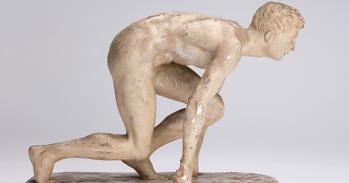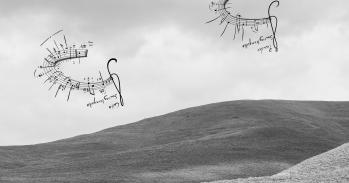
To mark the 60th anniversary of his death, an exhibition exploring Wittgenstein’s experiments in photography, and how they relate to his philosophy, can be seen at the University’s Photographic and Illustration Services.
To mark the 60th anniversary of his death, an exhibition exploring Wittgenstein’s experiments in photography, and how they relate to his philosophy, can be seen at the University’s Photographic and Illustration Services.
Wittgenstein was aiming for different clarity expressed by the photography of fuzziness.
Michael Nedo, Keeper of the Wittgenstein Archives
“Don’t think, look!” - Ludwig Wittgenstein
The woman with the haunted look staring back out of the photograph has never existed. She is a composite, created by overlaying four different photos of four different faces: three sisters, all middle-aged Austrian women, and their brother, the philosophical genius Ludwig Wittgenstein.
Made with the help of his photographer friend Moritz Nahr some time in the mid-1920s, the image is the result of a photographic experiment that Wittgenstein conducted based on the work of Francis Galton, an explorer, anthropologist, inventor of fingerprinting and, on a more sinister note, the founding father of eugenics.
Like his cousin Charles Darwin, Galton was fascinated by genetic traits, particularly the commonality of certain physical characteristics which for him represented the potential, higher or lower, of a person’s moral integrity. Galton used the process of composite photography to try and illustrate his argument by overlapping photographs of faces, in the hope of revealing the physical elements that ran through the groups of people he selected.
Wittgenstein had little interest in genetics, but he did have a love of photography, and employed the same technique some 50 years later, with a very different purpose. “Galton was aiming for enhanced sharpness and clarity,” explains Michael Nedo, Keeper of the Wittgenstein Archives. "Something which you could not see in an individual picture, but if you superimposed a number of pictures then it would become clear. Wittgenstein was aiming for different clarity expressed by the photography of fuzziness.”
Wittgenstein said of Galton’s photography that it was “the picture of a probability… what one glimpses”. Nedo considers this statement to be key when looking at Wittgenstein’s own experiments in this kind of photographic composition, Galton tried to force an explanation from what Wittgenstein saw as merely the briefest of descriptions.
“A photograph is a frozen moment, outside time. As Wittgenstein says it is ‘a probability’, not ‘all probabilities’, what one sees in the blink of an eye. But if you keep your eyes open you will see things move and change, nature as a dynamic event, and it is this constant changing that creates fuzziness on one hand but clarity on the other, because if you only glimpse then you exclude all other aspects, you have no greater clarity, you are blinkered.”
“Galton wanted to work out one probability, whereas Wittgenstein saw this as a summary in which all manner of possibilities are revealed in the fuzziness.”
The composite photograph could be said to mark the start of the development of Wittgenstein’s idea of ‘language game’ and ‘family resemblance’, that things assumed to be connected by singular common features, as Galton believed with facial characteristics, are in fact connected by myriad overlapping similarities that weave complex networks, the possibilities represented in the fuzziness. Wittgenstein later uses human families to relate this idea, where “build, features, colour of eyes, gait, temperament, etc. etc. overlap and criss-cross in the same way".
Nedo refers to Wittgenstein’s analogy of a rope to further describe this: “A rope is made of a huge number of fibres, but not a single fibre goes through the ropes entire length, it’s the way they overlap that creates the strength.” Wittgenstein would go on to use the idea to look at questions of language and mathematics in his philosophy.
Wittgenstein was drawn to the descriptive nature of photography, as the other works in the exhibition show. Excerpts from his photo albums reveal a more relaxed and playful side to a man who is often portrayed as a tormented soul. In one photo, Wittgenstein has convinced his friend Gilbert Pattisson to pose in the style of an American gangster movie, a genre of which he was a huge fan, telling him, in the language of these films: “go and case the joint!”.
A previous exhibition at Clare Hall also featured work from Eduardo Paolozzi, the Scottish sculptor and artist, some of whose work can be found in the grounds of Jesus College. Paolozzi was a keen follower of Wittgenstein’s philosophy, and produced a series of works of a similar composite nature, in which he took a single image of Wittgenstein and spliced it with a variety of other graphical elements, including the face of John Lennon, and Greek and Aztec stonework.
“What this work shows is what a creative effect Wittgenstein had on artists,” says Nedo. “I actually find the effect of his writings rather more fascinating within the works of art, whether poetry, architecture or visual arts, than amongst the majority of secondary literature created by philosophers.”
Michael Nedo has devoted much of his life to the works of Wittgenstein, meticulously editing volumes of what will be the complete edition of the great philosopher’s works. Since beginning the project in 1978, Nedo has so far completed 17 volumes, although he says that when its finished it will be “more like 70”. However, he remains undaunted, and dedicated to the task. Along with projects around Wittgenstein’s photography, next year will see a performance of a concert with reading at Clare Hall that Nedo has constructed around the philosopher's writings.
“Even after many years, my fascination with Wittgenstein is ever-growing, which is quite something. That’s - I believe - not a result of my naivety or sentimentality, it’s simply the greatest work of our time.”
The exhibition ‘Wittgenstein and photography’ runs at the Photographic and Illustration Service on the New Museums site until the 15th August.
This work is licensed under a Creative Commons Licence. If you use this content on your site please link back to this page.





